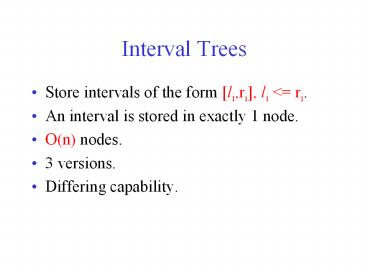Interval Trees - PowerPoint PPT Presentation
Title: Interval Trees
1
Interval Trees
- Store intervals of the form li,ri, li lt ri.
- An interval is stored in exactly 1 node.
- O(n) nodes.
- 3 versions.
- Differing capability.
2
Version 1
- Store intervals of the form li,ri, li lt ri.
- At least 1 interval per node.
- Static interval set.
- Report all intervals that intersect/overlap a
given interval l,r.
3
DefinitionVersion 1
- A binary tree.
- Each node v has a point v.pt and two lists v.left
and v.right. - u.pt lt v.pt for nodes u in left subtree of v.
- u.pt gt v.pt for nodes u in right subtree of v.
- So, it is a binary search tree on pt.
4
DefinitionVersion 1
- Intervals with ri lt v.pt are stored in the left
subtree of v. - Intervals with li gt v.pt are stored in the right
subtree of v. - Intervals with li lt v.pt lt ri are stored in v.
- v.left has these intervals sorted by li.
- v.right has these intervals sorted by ri.
5
Example
- v.pt 4
- L a, e
- R d
- v.left c, f, b
- v.right c,b,f
6
Properties
- Each interval is stored in exactly one node.
- Each node stores between 1 and n intervals.
- Number of nodes is O(n).
- Sum of sizes of left and right lists is O(n).
- Tree height depends on how you choose the points
v.pt.
7
Selection of v.pt
- v is the median of the end points of the
intervals stored in the subtree rooted at v.
- End points 1, 2, 3, 4, 5, 6, 7
- Use 4 as v.pt.
8
Selection of v.pt
- With median selection, tree height is O(log n).
- Median selection is possible only for static
interval set. So, no inserts/deletes. - Could relax to support insert/delete.
9
Find All Overlapping Intervals
- Query interval is l,r.
- v.pt e l,r
- All intervals in v overlap.
- Search L and R for additional overlapping
intervals.
10
Find All Overlapping Intervals
- v.pt lt l
- Intervals in v with ri gt l overlap.
- No interval in L overlaps.
- Search R for additional overlapping intervals.
11
Find All Overlapping Intervals
- v.pt gt r
- Intervals in v with li lt r overlap.
- No interval in R overlaps.
- Search L for additional overlapping intervals.
12
Find All Overlapping Intervals
- Complexity
- O(log n output) nodes encountered.
- All intervals in v overlap.
- Intervals in v with ri gt l overlap.
- Intervals in v with li lt r overlap.
- O(log n output) when v.left and v.right are
sorted arrays.
13
Version 2
- Store intervals of the form li,ri, li lt ri.
- Empty nodes permitted.
- Inserts and deletes.
- Answer queries of the form which intervals
include the point d.
14
Inserts Deletes
- Difficult in version 1 because v.pt is median.
- Select v.pt (almost) arbitrarily and use a
red-black tree. - Each node stores between 0 and n intervals.
- At most 2n nodes permissible.
- Tree height is O(log n).
- Interval placement rule is same as for Version 1.
15
Need For Empty Nodes
- Deletion from a degree 2 node.
16
Why Upto 2n Nodes Permissible
- When number of nodes gt 2n, at least 1 degree 0 or
degree 1 node must be empty. - Empty degree 0 and 1 nodes are easily removed.
- So, no need to keep them around.
- 2n suffices to avoid having to handle empty
degree 2 nodes.
17
LL Rotation
- Intervals change only for A and B.
- Those intervals of A that include B.pt need to be
moved into B.
18
Remaining Rotations
- All insert/delete rotations require relocating
intervals from O(1) nodes. - O(1) rotations per insert/delete.
- Complexity of insert/delete is O(f(n) log n),
where f(n) is time needed to relocate O(n)
intervals from one node to another.
19
All intervals that contain d
- d v.pt
- All intervals in v.
- Done!
20
All intervals that contain d
- d lt v.pt
- Intervals in v with left end point lt d.
- No interval in R contains d.
- Search L for additional overlapping intervals.
- d gt v.pt
- Similar
- O(log n output)
21
Version 3
- Store intervals of the form li,ri, li lt ri.
- Exactly 1 interval per node.
- Inserts and deletes.
- Report just 1 overlapping interval.
22
Version 3Structure
- Red-black tree.
- Each node has exactly one interval v.int and one
point v.max. - v.max max (right) end point of intervals in
subtree rooted at v. - Binary search tree on intervals. So, need an
ordering relation for intervals.
23
Interval Ordering
- Ordered by left end points. Tie breaker for equal
left end points. - i and j are two intervals.
- i lt j iff li lt lj or (li lj and ri gt rj)
24
Example
25
Version 3Search
- Search for an interval that has an overlap with Q
l,r - If v.interval and Q overlap, done.
- Otherwise, if v.leftChild.max gt l search
v.leftChild. - Otherwise search v.rightChild.
26
Version 3Search
v.leftChild.max gt l
l
- r
max
27
Version 3LL Rotation
- Max values changes only for A and B.
- A.max maxA.interval.right, BR.max, AR.max.
- B.max maxB.interval.right, BL.max, A.max.
28
Remaining Rotations
- All insert/delete rotations require computing max
for O(1) nodes. - O(1) rotations per insert/delete.
- Complexity of insert/delete is O(log n).































